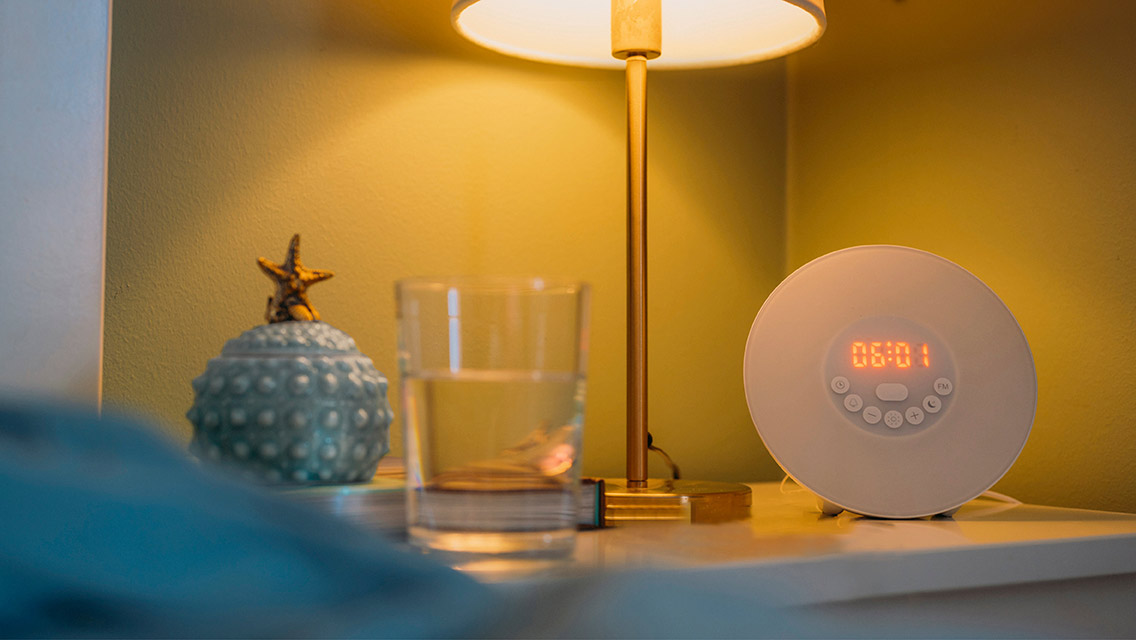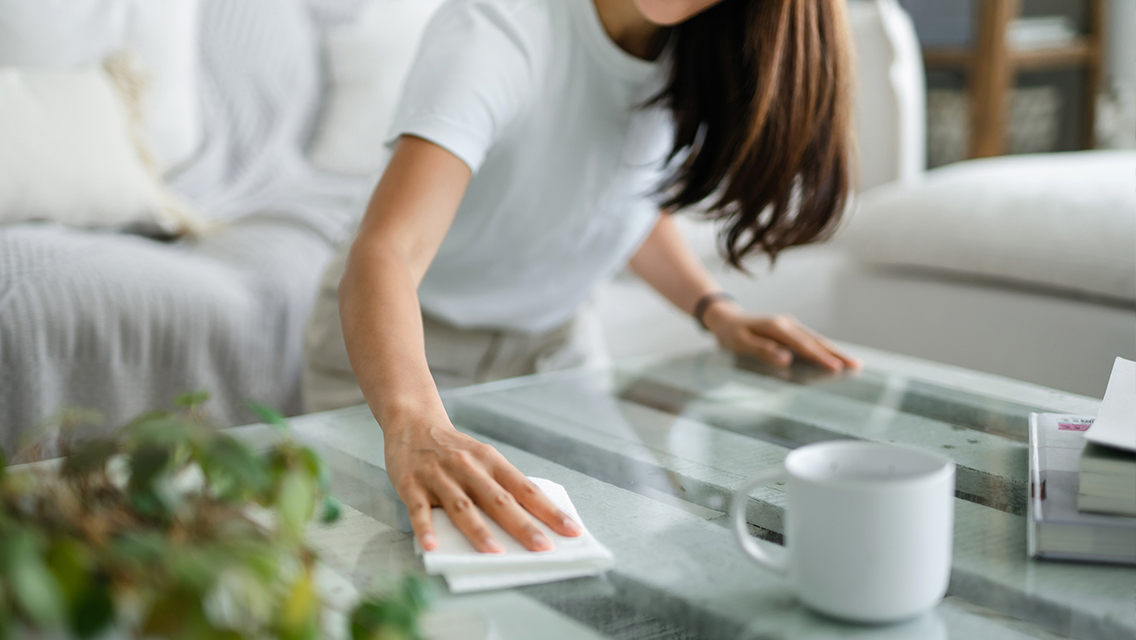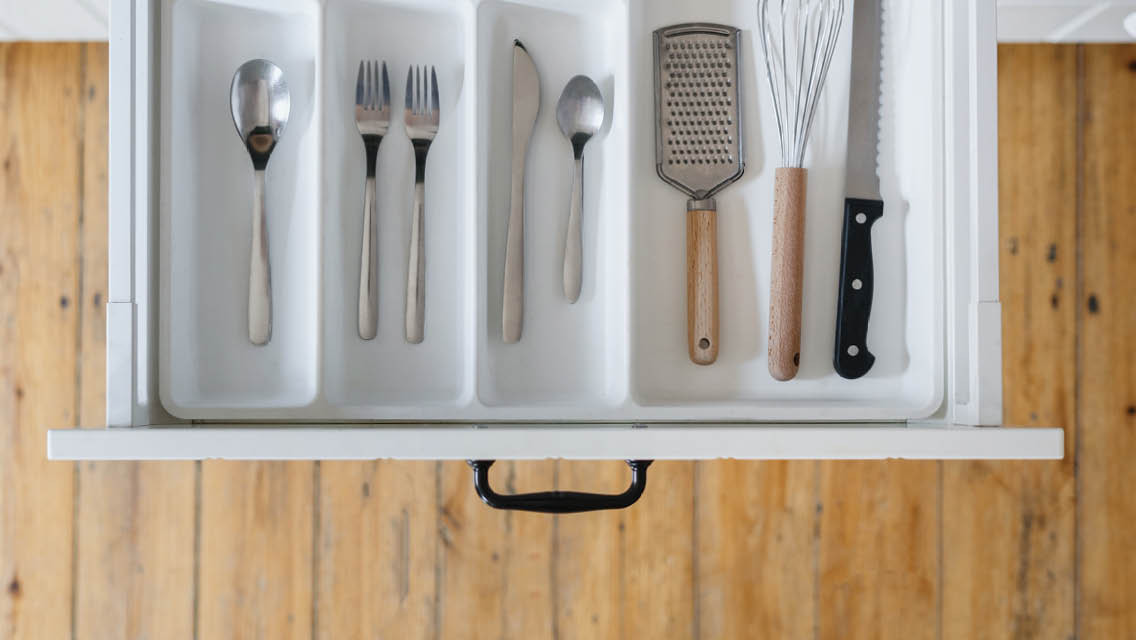Bedside Table ⋅ Home-Office Desk ⋅ Medicine Cabinet ⋅ Kitchen Table/Island
Fumbling in the dark, my hand pawed at the box of tissues and the stack of books on my nightstand, traced the base of the lamp and the container of earplugs, mistakenly grasped at the bottle of lotion, then whack: There went the glass of water. Lights on. Towels out. I was up in the middle of the night once again, sopping up a watery mess.
I wish my bedside table were the only cluttered area in my home.
With two work-from-home adults and a homework-afflicted teenager in our house, pretty much every horizontal surface is fair game for books and papers, miscellaneous technology, and bags and backpacks.
Clutter can disorient, distract, and drain us. One UCLA study showed that people who described their homes as cluttered displayed elevated cortisol levels compared with those who did not. Research has also suggested that cluttered spaces tend to be linked with procrastination and mindless snacking, habits that undermine both mental and physical well-being.
In short, our spaces affect us more than we know.
“Every object our eye lands on, even if it’s so fast we’re not conscious of it, has an associated thought or feeling,” explains feng shui and decluttering expert Andrea Gerasimo.
When our eyes perceive clutter and disorganization, we can feel overwhelmed. When we routinely spend time searching for everyday items like phones or keys, it adds to mental fatigue. And when the clutter carries emotional weight, as with memorabilia or eternally unfinished projects, we can feel stuck in place.
“When we don’t feel good mentally, we’re in a poor position to take action,” explains residential organizer Katie Tracy, author of Behind the Closed Door: The Mental Stress of Physical Stuff. “It’s not just that the physical space impacts us mentally. It’s also that our mental space impacts how well we can maintain systems or create change in that space. It’s cyclical.”
Mindset Over Matter
If you’re constantly digging through piles and moving stacks around to get to what you need, your stuff may have more control over you than you have over it.
“Once clutter [starts] impeding you from living a healthy, efficient, and beautiful life — then it’s a problem,” says Laura Benko, author of The Holistic Home: Feng Shui for Mind, Body, Spirit, Space.
There’s no single right way to declutter, but most experts agree that it’s important to start small and let go of the idea that any space will be clutter-free forever. “Think of decluttering as a process, not a project,” advises Tracy.
“The last thing you want to do is decide you’re going to do all of it,” adds Gerasimo, who suggests beginning with a single drawer — or even your wallet. “The gratification of that, even if it’s the only space in the house that’s clear, is powerful.”
In the spirit of starting small, we’ve asked our experts for decluttering guidance in four modest spaces in the home. They showed us how a little decluttering can have a big impact when you focus on the areas you use the most.
1) The Bedside Table
The nightstand is the command center of the bedroom: We want everything within arm’s reach after we’re tucked in. While sleep experts recommend using our beds only for sleep and sex, many of us use them for multiple purposes, including reading, working, studying, and even eating. “When we treat our bed like a workplace, then it tends to collect more,” says Benko.
Why decluttering matters: The bedside table is one of the last things we see before we fall asleep and one of the first things we see when we wake up. That’s one reason it has an outsized impact on how we feel. “We’re highly impressionable to the imagery in our bedroom,” Benko explains. “So be mindful of the messages that surround you while you rest and restore.”
Think of things that usually occupy the nightstand: books you haven’t read yet, maybe the spreadsheet for tomorrow’s meeting. It might be littered with used tissues and other detritus. Benko argues these items are all loaded with symbolism that can interfere with sleep, so clearing this surface can contribute to a better night’s rest.
How to declutter: A perfectly clear surface isn’t necessarily the goal. For some people, a small stack of books may be more inspirational than stressful. The main objective is simply to relocate any objects you don’t use nightly to a more appropriate location.
The same goes if your bedside table has a drawer — limit what you store there to things you use on a nightly basis, like earplugs, an eye mask, and moisturizer. Clear out any extra power cords, pens, and other random items that may have found their way in. Once this space is decluttered, it can be relatively easy to keep clean. As part of your morning or evening routine, take 30 to 60 seconds to put things away and reset your space.
If miscellany does creep back in, you can create systems to contain it. I told Gerasimo about the two years’ worth of dead AAA batteries from my clip-on book light rolling around in my nightstand drawer. She suggested putting a snack-size Ziploc in the drawer that holds no more than a half dozen depleted batteries at a time; when that’s full, it’s time to recycle them.
How to defend with beauty: Benko recommends placing a natural object on your nightstand to discourage clutter and set the energetic stage for restful sleep. “A crystal or a simple flower arrangement will [suggest] a connection to something bigger than you, something that is universally connective.”
2) The Home-Office Desk
Bills to pay. Receipts to file. Appointment reminders, report cards, grocery lists. If there’s a vaguely important piece of paper in the house, the home-office desk draws stuff to it with the force of a rip tide. And even with the mostly digital nature of office work, the biggest desk can still feel too small for active paper files and office supplies.
Why decluttering matters: The home-office desk serves as a de facto to-do list for our lives, so it feels especially overwhelming when it’s a mess. If we also work from home, that feeling may be compounded. A recent study from DePaul University found office clutter predicts emotional exhaustion and stress.
On the flip side, its centrality means that decluttering the desk can be especially rewarding. “In feng shui, the desk represents your vocational path,” says Benko. “From an energetic point of view, you want to give yourself a boost wherever you can.”
How to declutter: Experts recommend starting with a clean slate. Take everything off your desk for a week and place it nearby. During that week, identify the items you use daily. Anything you don’t use gets a new home on a nearby shelf or in a drawer.
When you’re choosing what to keep, respect your natural work tendencies. If you’re a paper person, there’s no need to force yourself to go completely digital, says Tracy. Simply create filing systems that reflect the action-oriented nature of your paper.
“When we think about categories of paper, our tendency is to put a noun to them: These are my bills, these are my appointments,” she notes. “Think instead in verbs. What action do I have to take? So, ‘bills’ becomes ‘to pay.’ Messages and follow-up reminders become ‘to call.’ That way, you’re grouping the same types of actions together.”
Another way to cut down on visual clutter: Keep track of to-do items on your calendar instead of posting reminders around your desk. “Sometimes you don’t have time to wrap your head around a complex topic such as home insurance and go down all the paths of inquiry and consideration,” says Gerasimo. “But you can schedule a time to deal with it later so you can quiet your mind and attend to the things you need to do now.”
As you develop the systems that work best for you, consistency is key. “Once a week, reset,” suggests Tracy. Take a few minutes at the end of each week to put your desk back in order. And if the piles do return, don’t be too hard on yourself. Just clear everything off again and start fresh.
How to defend with beauty: Placing a houseplant or a small statue on your desk not only discourages clutter; it gives your eye something pleasant to land on while you’re working, suggests Gerasimo. “This gives your desk visual structure and creates more mental ease.”
3) The Medicine Cabinet
Items in a medicine cabinet (or bathroom drawer or shelf) have a way of proliferating. “We think, Well, this is a medicine-y, first aid-y, bathroom-y kind of thing, so I guess I’ll just throw it in the medicine cabinet because I don’t know where else to put it,” says certified organizer and life coach Sara Skillen. Next thing we know, the space is stuffed — and good luck finding the tweezers.
Why decluttering matters: Some toiletries, grooming supplies, and medications will be in daily rotation, while others get used only occasionally. A well-organized medicine cabinet will keep them separate, helping to ensure you don’t accidentally take the wrong medication or buy more tubes of hair gel or toothpaste than you need.
How to declutter: Many items in a medicine cabinet are consumable, so start by weeding out expired items along with those no longer in their prime. Pull out first aid and medical supplies that you aren’t currently using and store them together in a separate space.
Next, find duplicates of products and put the spares in an “overstock” container. When you run out of something, shop your overstock stash first. Consolidate half-filled bottles when possible, and if you have just a bit of lotion or soap left in a container, Gerasimo suggests, decant it into a small jar to make it easier to use up.
Finally, wipe down the shelves and arrange the remaining items for convenience. “Keep your daily self-care items [like your toothbrush and toothpaste] in the area that’s easiest to reach,” she says. Place more occasional-use things — nail clippers, tweezers, razor — higher up. That way you won’t have to push aside the nail clippers twice a day just to get to your toothbrush.
How to defend with beauty: “Let something beautiful hold the mundane,” advises Benko. For example, rather than leaving cotton swabs in their plastic clamshell, transfer them to a pretty glass jar. Seeing something a little bit lovely every time you open the medicine cabinet can be surprisingly satisfying.
4) The Kitchen Table/Island
The kitchen is where we congregate. It’s where we cook meals while kids do homework, where some of us sort the mail and pay the bills, and where the lighting is best for projects, puzzles, and games.
It’s also where we dump our stuff. “When people come home, they’re tired, and they often don’t pause and take the extra steps to put the bags away or sort the mail they just brought in,” says Skillen.
Why decluttering matters: This high-traffic area is used every day, which makes it easy to clutter. Still, we need to keep it clear of things that get in the way of preparing and eating food.
“We call it the shuffle,” says Tracy. “You shuffle stuff from the counter to the table so you can make dinner, and then you move it from the table so you can eat dinner, and it ends up back on the counter.”
Skillen notes that “we’re going to be healthier if we prepare our meals at home and sit down and eat together. If there’s too much stuff on the kitchen table to sit down, everybody’s going to park where it’s easy and most comfortable, often in front of the TV.”
How to declutter: The kitchen table or island is ultimately meant for eating; it isn’t really designed for activities like working, paying bills, or playing games. But that’s how we use it, so rather than trying to relocate these activities, we can create systems to accommodate reality.
For example, if your kids like doing homework at the table, Skillen suggests buying a small caddy or rolling cart where they can stash their books and papers when it’s time to eat. “You can roll it away from the table and it doesn’t have to be a big production,” she says.
If you regularly pay bills or do other paperwork at the kitchen table, set yourself up to do so officially by keeping your checkbook or files in a cabinet or drawer near the table, advises Tracy. You can also create other spaces nearby for incoming stuff — a basket for mail, a bowl for keys, hooks for bags. Keeping the kitchen table decluttered is largely about creating systems to accommodate its many uses.
How to defend with beauty: Gerasimo explains that placing something beautiful — a special bowl, a silver platter, a bouquet — in the center of the table or island creates a sense of structure and discourages the willy-nilly depositing of clutter. “There’s something about a thing of beauty that says, ‘Don’t just come and set all your crap down here!’”






This Post Has 0 Comments